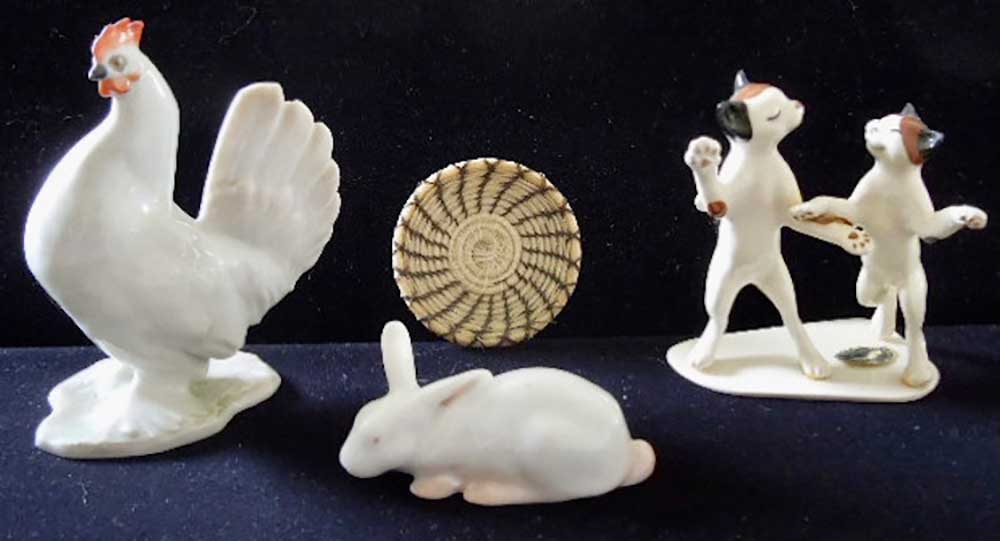December 2021
Good Eye
Dealing in miniatures and other smalls
by Peggy Whiteneck
Small and Miniature items
Recently, I’ve begun to face what every dealer or collector eventually must: an ever-growing collection of acquisitions with limited display or storage space. Still, if you’re a collector-dealer like me, you’ll probably be able to relate: the lack of space doesn’t seem to prevent us from acquiring the next great item we see! To address limitations in display space, I’ve recently come upon a strategy, for gift-giving for my sisters with their own space challenges as well as for myself, of purchasing small and miniature items that can fit in just about anywhere.
The challenge is collecting worthwhile smalls while avoiding dime store, no-name riffraff, so I’ve made it my business to develop a trained eye for quality in small details. If it isn’t marked or I suspect I won’t be able to find it identified in my several books on antiques and collectibles, I don’t buy it.

Examples of great smalls
Quality pottery and porcelain produced by companies from Rosenthal, Lladró, Royal Copenhagen, and Staffordshire on the high end to Freeman-McFarlin, Josef’s Originals, and Hagen Renaker at the more affordable end are good examples of small to tiny items worth buying and/or re-selling. Small glass items by companies such as Fenton or Mosser, from miniature mugs and pitchers to small glass animals, would be good candidates for acquisition by either children or adults and don’t take up a lot of display room. Any of these very small items can command an outsized value, making them worthwhile for dealers to acquire
(The most desirable Fenton small animal figurines, for example, are hot right now; those that used to sell a few years ago for $35-$45 are now selling for $75-$100, even on the bargain paradise of eBay. Older Fenton miniatures that are 2” tall or less, such as tiny vases, mugs, and baskets from the #37 mould, can be found on eBay for prices from the affordable to the astronomical, depending on age and glass treatment).
Some miniature clay and ceramic animal options that are very affordable, especially for children starting a collection, were made by Wade, Josef’s Originals, and Hagen-Renaker. Most of the name brands have at least one collector book focused on identifying individual models (For Hagen-Renaker, for example, I use Gayle Roller’s Hagen-Renaker: The Charlton Standard Catalogue. And I have a small library of reference books on everything else I collect!).
Jewelry, of course, is inherently size-limited, and even some vintage costume jewelry by known designers such as Miriam Haskell, Dior, and Weiss can command big prices. Jewelry by known makers, whether in costume or finer materials, is often marked on the inside of rings or the clasps of neckpieces and bracelets.
Victorian silversmiths loved making small, prettily decorated table utensils such as elaborate sugar spoons, the oldest examples of which were done in sterling silver. (Plated silver came into vogue in the mid-19th century). Again, research is important for distinguishing the junk from valuable items. Wealthy Victorians might lay out as many as 10 individual silver utensils at each table setting.
Careful: there’s a lot of junk out there!
There are many more high-quality smalls and miniature types than I am able to mention in a short article. I’ve found that dealers who sell quality smalls and miniatures are too few and far between. Most of the miniatures I see in antique stores are large displays selling stuff worth about as much as pieces of roughly-used plastic doll house furniture. It’s hard to find dealers who restrict their acquisitions to quality items that are so small they’re sometimes hard to identify except with a “good eye.”
I’ve learned to look at the junk displays anyway, since every once in a while, I find a diamond in the rough among the stuff-not-worth-buying. I spend most of my shopping time, though, looking at displays by dealers whose inventory shows they know how to distinguish the good from the bad.
Peggy Whiteneck is a writer, collector, and dealer living in East Randolph, VT. If you would like to suggest a subject that she can address in her column, email her at allwritealready2000@gmail.com.

